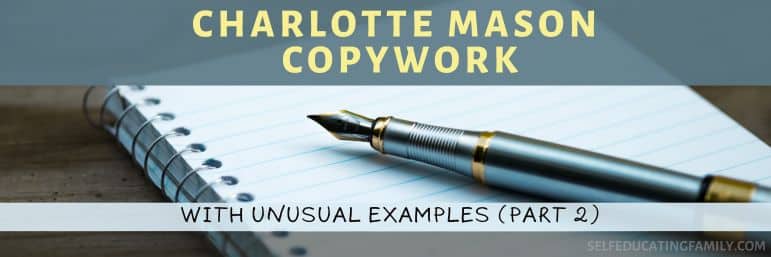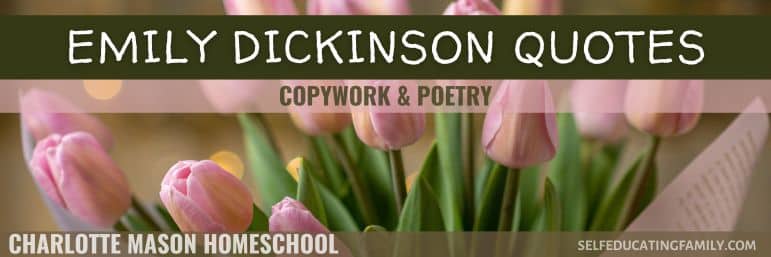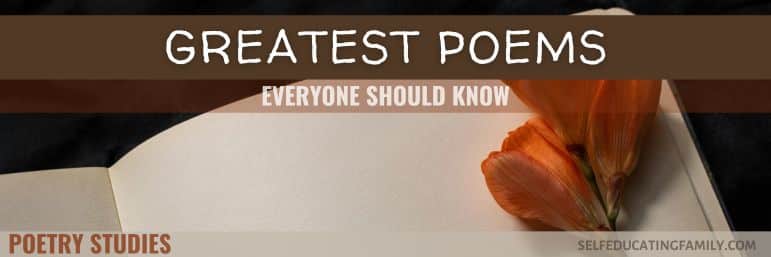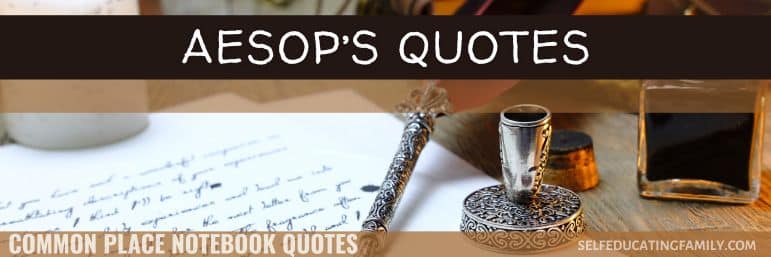Where to find more Free Copywork passages
This post showcases where to find free copywork passages, and is the second and final part of a mini-series on Charlotte Mason copywork.
To learn about the details of Charlotte Mason Copywork, see the first part of this article.
If you need to review the basics of copywork, refer to What is Copywork?
This post will focus on locating good passages of free copywork directly from the books your child is reading.
Disclosure: This post contains affiliate links, meaning that if you make a purchase after clicking through, SelfEducatingFamily will receive a small commission at no extra cost to you.
Quick overview of Charlotte Mason & Copywork
Lessons are to be short. This includes copywork, which should take 5-15 minutes. You will set the content for the child, and eventually, lessons progress to the point where the child selects his own passages to transcribe into a commonplace notebook and finds & makes all corrections as needed.
The content is from great literature – from the living books that your child is reading.
Typical sources of Copywork
The easiest places to find great passages to copy are from your literature, history, and bible studies. This was discussed in Part 1 of this article.
Charlotte Mason Subjects
As you may know, Charlotte Mason methods use many subjects. By my count, it’s over 25 different subjects.
While I recommend sticking with the big 3 daily subjects for the easiest to find and best examples of copywork, many of these other subjects can be a great source also. Let’s now look at these with specific passages to see what I mean.
Examples from Other subjects for Year 4
We were looking at Year 4 in Part 1, so we will continue with that example. I’m using the booklist from Ambleside Online free curriculum.
Poetry
Poetry runs a close second to the big 3 for easily finding great copywork passages. If you use Ambleside online free curriculum, you generally turn to 3 poets a year, giving you ample opportunities for copywork. For instance:
- “And then my heart with pleasure fills,
And dances with the daffodils.” — from Daffodils byWilliam Wordsworth - “Alone and warming his five wits,
The white owl in the belfry sits.” — from The Owl by Alfred Lord Tennyson
Sometimes, whole poems are small enough for copywork. Like Dickinson’s The Pedigree of Honey:
The pedigree of honey
— Emily Dickinson
Does not concern the bee;
A clover, any time, to him
Is aristocracy.
Shakespeare
Shakespeare copywork selections are usually from the current term’s play. My favorite sources to find the best Shakespeare quotes are Bartlett’s Shakespeare Quotations or No Sweat Shakespeare. I liked to make the best quotes into bookmarks for the term that the kids could then use for copywork or recitation.

Here’s an example from Richard III:
“A Horse! A Horse! My kingdom for a horse!” — Richard III: Act V, scene iv, line 7
Geography
Living geography books are always good for some tantalizing quotes that remind you of the story.
- “John remembers a time when the family was still living on the sheep ranch and he was sent to catch a porcupine for dinner.” — from What the World Eats by Faith D’Aluisio.
It’s also a great idea to throw in some geography definitions to change things up a bit. For instance, the water cycle has lots of details:
- “What happens when a kettle of water is put on a hot stove?
The water gets hot and boils away.
Where does it go? Is it destroyed?
The water is changed, but it is not destroyed. Coal burns, but we do not get rid of it altogether. It is changed into gas and smoke and ashes.
What is the water changed into?
It is changed to vapor. If we let the kettle remain on the fire long enough, the water it contains will all pass away as vapor.” — from LESSON XIV: HOW WATER IS CHANGED TO VAPOR from Home Geography by C.C. Long (in the public domain)
Plutarch
Any single sentence from Plutarch will suffice. Generally, I would look for a sentence introducing the main person in your citizenship study. For instance:
- “Marcus Brutus was descended from that Junius Brutus for whom the ancient Romans erected a statue of brass in the Capitol among the images of their kings with a drawn sword in his hand, because he had valiantly put down the Tarquins from their kingdom of Rome.” — from Plutarch’s Life of Marcus Brutus.
Tip: Use Ambleside Online’s study guides to make Plutarch more accessible. It is difficult reading, but the way that most of their study guides present the material is delightfully approachable. Their suggestions were so helpful once I understood that a single paragraph at a time is acceptable!
Nature Study
While nature study is primarily learning via hands on – being out in nature and making observations, either with words or drawings – you can occasionally throw in a sentence for copywork. Anna Comstock’s Handbook of Nature Study is the go-to guide. And of course, any other books you use in nature study may be good for copywork. In fact, this can be a good opportunity to allow the younger student to begin to select their own passages. If your child has expressed a crazy interest in a subject, ask them to find a sentence about it. For example, I had a friend whose son became wildly obsessed with learning everything about birds. You could ask the child to turn to the bird section in the Handbook and select a sentence about a favorite bird.
- “Most of us think we know the robin well, but very few of us know definitely the habits of this, our commonest bird.” — Anna Comstock’s Handbook of Nature Study, p 57
Sometimes, a sentence like this can ignite a child’s interest to dig deeper into the subject.
Math
Math is another subject for a source of unusual copywork. While most of your copywork will come from literature, poetry, biographies, and history, sometimes adding these off-topics is fun.
For math, unless you or your child finds a great passage from a living math book, a source could be a memory concept or a definition. For instance, for year 4, “order of operations” is a concept they must learn. One day, you can make a copywork of the acronym for order of operations:
- In mathematics, the Order of Operations: PEMDAS – Parenthesis, Exponents, Multiplication, Division, Addition, Subtraction.
It’s silly but may be a good break from the usual.
Science
Science, like geography, can have both passages from the living books you are reading or definitions of the concepts you are learning. Here are a few examples of each kind:
- “You find it dull walking up here upon Hartford Bridge Flat, this sad November day? Well, I do not deny that the moor looks somewhat dreary, though dull it need never be.” – from A Walk Through the Glen: Kingsley’s Lessons in Earth Lore, Volume 1 of Madam How and Lady Why by Charles Kingsley
- “The next day Emile, when only half awake, began to think of the ants’ cows. “We must beg uncle,” said he to Jules, “to tell us the rest of his story this morning.”
No sooner said than done: they went to look for their uncle.” – from Chapter IV of The Storybook of Science by Jean-Henri Fabre. - “As long as Isaac could remember, he had lived at Woolsthorpe Manor with Grandmother.” – from The Ocean of Truth: The Story of Sir Isaac Newton by Joyce McPherson
- A moor: 1. chiefly British: an expanse of open rolling infertile land, or 2.: a boggy area, n especially: one that is peaty and dominated by grasses and sedges.
- “And to every action, there is always an equal and opposite or contrary, reaction” ― Isaac Newton
Biography
Biographies are rich for quotes. We always liked to find quotes about the subject of the biography.
- “When John and Abigail could not be together, they wrote letters to each other, letters full of wit and devotion, to bridge the days when they could be together again.” ― from Abigail Adams: Witness to a Revolution by Natalie Bober.
Artist
Artist, like Shakespeare, is dependent on the current term. In general, artist study is about the pictures. Also, a brief biography is recommended or a series of good living books about the artist can be helpful. Here is a representative type of copywork for Van Gogh. It’s the opening sentence from The Yellow House:
- “While it was still dark, shortly after five o‘clock in the morning, a train clanked into the station at Arles, and a solitary, exhausted passenger got out.” ― from The Yellow House by Martin Gayford.
Composer
With Composer, like Artist studies, finding some good living books about the composer as a supplement to listening to the compositions is beneficial. These books can be a source of copywork. Alternatively, if any of the compositions being studied for the term have lyrics, those can be used for copywork also.
And here’s a weakness of mine. I think it is very amusing to have clever musicians make fun of classic pieces by great composers. If you’ve ever seen the Bug Bunny Classic Hungarian Rhapsody in which Bugs plays Liszt’s piano concerto, it’s a crowd pleaser.
Also, we used a series of humorous spoofs of classical music by contemporary artist Richard Perlmutter where he plays classical pieces and adds his own memorable lyrics to the tunes. These make fine copywork, if you think this kind of thing is funny.
Here’s some “new” lyrics to “La Donna e Mobile” from Rigaletto by Verdi:
- “When you’re an opera star, With a large repertoire, How do you please the crowd? Sing Verdi very loud.” ― Lyrics by Richard Perlmutter of Beethoven’s Wig
The artist is very clever. We did get a chance to go to one of his concerts when the boys were small. Here’s another of his songs:
Say what you like, but my kids remember a number of composers and their works because of Beethoven’s Wig songs.
Hymns
A great source of copywork for changing things up can be the lyrics to your hymns and folksongs that you are learning each semester. Again, like Shakespeare, Artist and Composer studies, Hymns and Folksongs change by year rather than grade. You typically study them together as a family, often in morning time. The chorus or refrains are usually good to try. Here’s some sample hymn lyrics that might make gook copywork:
- This is my Father’s world,
And to my listening ears
All nature sings, and round me rings
The music of the spheres. ― from This is My Father’s World - Count your blessings,
Name them one by one,
Count your many blessings,
See what God hath done! ― from Count your Blessings - Then sings my soul, my Savior God, to thee:
How great thou art! How great thou art! ― from How Great Thou Art
Folksongs
Ditto for folksongs:
- Come and sit by my side, if you love me
Do not hasten to bid me adieu
Just remember the Red River Valley
And the one who has loved you so true ― from The Red River Valley - Waltzing Matilda, Waltzing Matilda
You’ll come a-Waltzing Matilda with me; ― from Waltzing Matilda - Whoopee ti yi yo, git along little dogies,
For you know that Wyoming will be your new home. ― from Git Along Little Dogies
Free Reading
Free reading selections are living books that the child wants to read in their off time. Typically, the beauty of free reading is that nothing other than reading it is required. So unless the child asks to do copywork from their free reading, don’t use copywork from those sources.
What does it usually look like if they ask for copywork? Typically, the child really enjoys the free reading selections and wants to share them with you by telling you about the story (narration) and sometimes prefers to make selections themselves for copywork from the book they are reading. Let it happen naturally.
Of course, be on the lookout for the kids who are just trying to find the shortest possible copywork.
But if requests never happen, don’t push them.
More free copywork passages
I’ve gathered and explained how I like to find copywork passages so that you can do this yourself and teach your kids to make their own selections.
But if you need more ideas or just a quick list of great quotes for copywork, refer to Aesop’s Quotes or Summer Themed Poetry Quotes. If you want a longer guide on Poetry Studies and how to use copywork, learn more about my eBook: The Poetry Hater’s Guide to Loving Poetry.
I’ve also put together a number of free downloads in the Free Library under copywork. Sign up for our weekly newsletter to get access to the library.
Here’s a sample for 4th year using all the passages I’ve described above in this article.
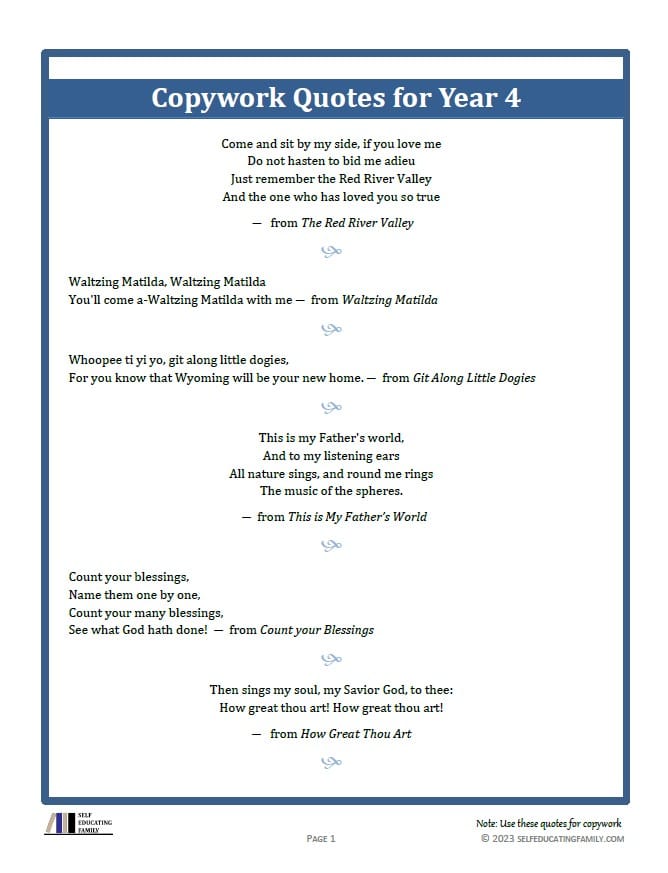
Keep Learning
For more learning


